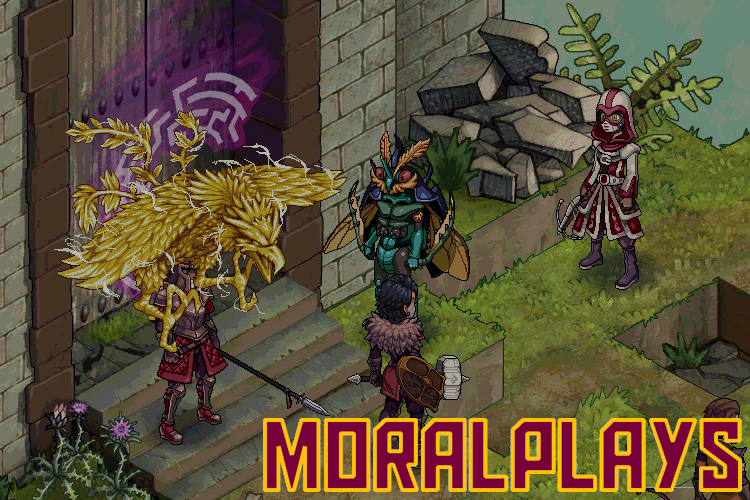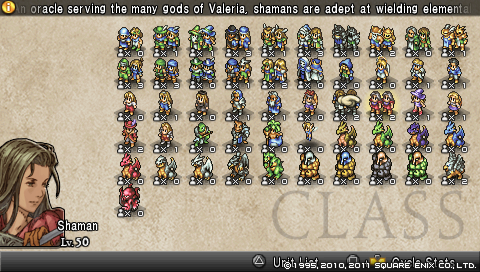MoralPlays #1: Labors of Love
I’ve never met Yasumi Matsuno, or Hitoshi Sakimoto, but they’ve had an incredibly outsized impact on my life.
You see, these two men respectively wrote and composed the music for two of my absolute favorite roleplaying games: Tactics Ogre: Let Us Cling Together and Final Fantasy Tactics—both mid-90s releases on the original PlayStation that, as I discovered writing this article, have since both been updated and rereleased on the PSP. The FFT re-release, dubbed War of the Lions, is also available for iPhone and iPad. Not that any of you would know about any games being available for iPad.
I must’ve been about seven or eight when my cousin Andrés showed me the original Final Fantasy Tactics and let me play as Cidolfas Orlandu—who, as a character with access to approximately four million powerful skills, was as broken as his name was stupid. (War of the Lions updates his name to . . . Cidolfus Orlandeau. I got nothing.) I was hooked, and I’d beg both him and my best friend for playing time whenever I saw them, even though I was, let’s be clear, wretchedly horrible at the game. I know I was eight, but the fact that I didn’t really understand how levels worked, or that occasionally doing something other than going for the direct damage skill might result in a more convincing victory later on, remains embarrassing to this day.
Later, I ended up renting Tactics Ogre: Let Us Cling Together a fair amount, back when renting games was a thing that people did a lot, and somehow, it took me a while to realize that it was a sort of embryonic version of the game I’d fallen in love with. Both games eventually released versions for the Game Boy Advance, and I’ve played them both.
So, with all that in mind, see if you can spot the similarity between this games, perhaps the very thing that brought me to love them so much:
Of course, it probably helps that Matsuno and Sakimoto are, apparently, colossal Queenheads. Let Us Cling Together (the subtitle for Tactics Ogre) is a Queen song, as is March of the Black Queen, the subtitle of another game in that series; and as someone who owns both soundtracks, I’ve noticed more than a tinge of Queen’s influence in their composition.
But, as I am fond of saying, this is all setup. The punchline is that, last August, 6 Eyes Studio, a small outfit based in Orlando, FL, decided to release this incredible thing called Fell Seal: Arbiter’s Mark. Yes, the title is ridiculous. Yes, 6 Eyes updates it with a frequency I can only describe as fervid—build 0.7.2 came out on the 1st of this month, followed by 0.7.3 last Friday, followed by 0.7.4 just this Monday.
But, I think, the picture below will show you why I instantly knew I’d be into this game:
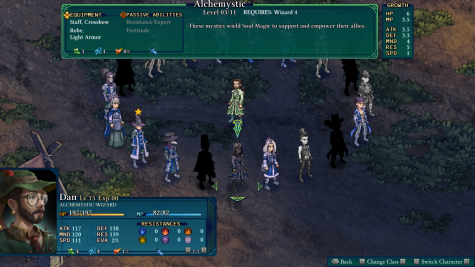
Fell Seal: Arbiter’s Mark has a plot so by-the-numbers for this type of game that I’m convinced it has to be homage. You play as Kyrie, an Arbiter (read: cop) who finds herself ill at ease with an environment where many Arbiters and Chapterhouses (read: police stations) can’t be trusted. Eventually, she agrees to become a Marked (fast-tracked to be a boss cop) so she can investigate which of the Immortals (the current boss cops) has been preventing everyone else from having nice things, and on the way discovers that the Temples she has to visit and the Relics she has to interact with may be altogether more sinister than she expects.
So yes, the plot is not so much derivative as it’s cognate. But if you’re playing Fell Seal mostly for plot, you’re missing the point. This kind of game breathes character customization through every pore. Sure, the game itself could stand to have a wider color palette (especially for hair and eyes), but the real customization isn’t in the graphical details—it’s in how you set up your characters to be absolutely hecking broken, and here, Fell Seal absolutely trounces its predecessors. Look at our guy Dan:
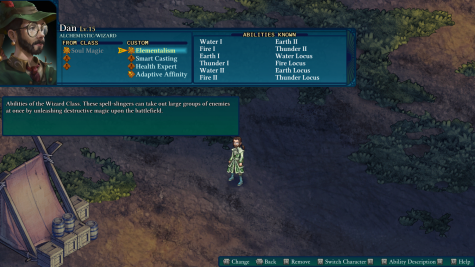
Dan’s an Alchemystic, so his main skill tree is Soul Magic. He’s not a very good Alchemystic just yet (classes in Fell Seal level up based on AP, which is independent of the character’s overall level and which you acquire by completing maps), so he doesn’t have much else going on there. But he does have an entire set of Elementalist magic from his old days as a Wizard, and his abilities grant him extra hit points and, basically, turn off friendly fire.
Eventually, Dan will gain access to abilities like Haste, which will let him make himself or others faster (which means more elementally-based destruction) and Resistance Expert (which I could use to make him a lot harder to hurt via magic). And that’s just from this one class combination! As Dan gains levels in other classes, I can use their abilities as well. Tactics Ogre barely allowed any of this, and Final Fantasy Tactics only allowed you to equip one extra ability set, one counter ability, one equip ability, and one movement ability; here you can get the two passive skills for your class as well as any two you’ve earned from somewhere else. I didn’t think it would be a big deal, at first; but then I learned that a knight who can hold a spear in one hand and a shield in the other survives a lot longer than one that’s just got some extra hit points.
The fact that Fell Seal provides that all-important experience—combining abilities, equipment, and a little bit of fictional generalship to create a character that seems thoroughly unfair—is proof that 6 Eyes loves these games as much as I did and do. It’s also why the guy in this shot, getting picked up by a thunderbird, is well and truly done for.
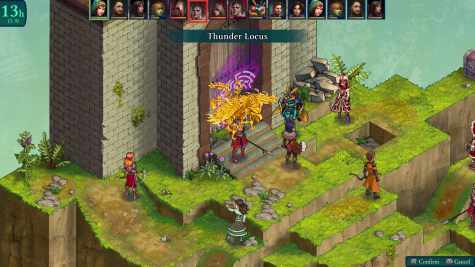
As of today, I’ve put 82 hours into Fell Seal since August, and the main impression I’ve gotten so far—because, honestly, I’m barely out of the first act—is one of profound respect for the games that inspired it, especially Final Fantasy Tactics. Sometimes that becomes almost ludicrous; the first real boss encounter is an outright calque of the first real boss encounter in Tactics, right down to the character having the same name. Sometimes it’s much more subtle, such as the fact that the first two classes are still a fighter and a healer.
But while I don’t know whether the plot or the characterization will remain quite as strong (there’s certainly been nothing to equal the famous “Blame yourself, or God” from Tactics just yet), I can say with some confidence that the gameplay itself is a huge improvement. The ability to run back to older battlefields for easier fights is a godsend when characters drop out for a few fights; the fact that you can generate new recruits at higher levels and advanced classes can help if you really, really need someone good at a particular task; the crafting element is relatively well done and allows you to manufacture a lot of gear you’ll actually use; and, as mentioned before, the fact that you can basically equip four always-active bonuses on a given character can really help create a squad that matches your play style without being so specialized it gets torn apart by a clever enemy.
The precision of those improvements tells me that, beyond making a darn good game, 6 Eyes set out to make a game they would have loved to play. I know they had a downhill battle to fight with me, given everything you’ve read before now, but I’d have to say they succeeded beyond all my expectations. If you’ve ever wanted to customize a squad of soldiers into a well-oiled victory machine, get Fell Seal. Let me know the first really broken build you discover.
